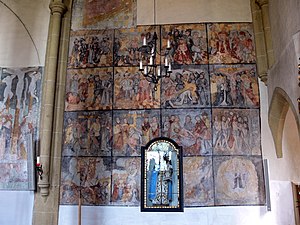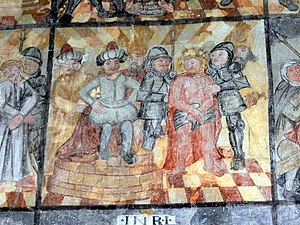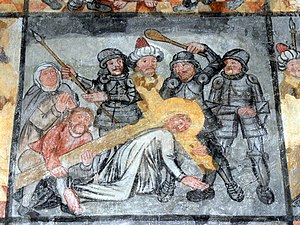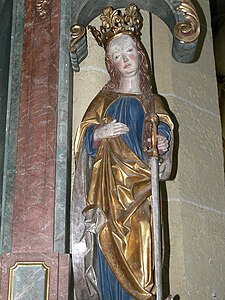Parish church Bischofshofen
The Roman Catholic parish church in Bischofshofen is located in the municipality of Bischofshofen in the St. Johann im Pongau district in the state of Salzburg . The parish church of St. Maximilian belongs to the deanery St. Johann im Pongau in the archdiocese of Salzburg . The church is a listed building .
history
The church stands on the site of the Cella Maximiliana (Maximilianszelle), the mother settlement of the Inner Mountains , which was founded by St. Rupert and the Bavarian Duke Theodbert ; it is as old as the diocese of Salzburg and the Nonnberg monastery, which was built at the same time in 711/12 . In the 11th century, the Augustinian Canons Pongau (Pongo, Pongowe) developed from this .
According to the results of excavations in 1953, the previous building was found. This church was the Augustinian monastery church. The transverse structure was about the same size as the current one, with five altar posts in rectangular niches. An exact date for the previous church could not be made, the 8th and 11th centuries come into question. The Rupertus Cross from Bischofshofen , the oldest known Christian art object in Austria, which can be found in the Diocesan Museum in Salzburg today , also comes from her .
1215, the branch was the bishops of Chiemsee used, the new suffragan of Salzburg, given its operators, the aufließen the monastery, the establishment of its headquarters, and from then Bishop mentioned monastery in an asset, the Kastenhof , transformed. The church was - instead of the Liebfrauenkirche - the new parish church of the legally sovereign Chiemsee Hofmark , while that remained with the parish church Pfarrwerfen . The current system is likely to date from this time. It represents a conception with a transept and crossing tower that is rare for the Alpine region and is reminiscent of Rhenish models of that time. The transverse system was probably added in the 13th century, the choir , of which remains of today's masonry are preserved, probably added in the 14th century. A choir consecration was reported in 1327. Remnants of the late Romanesque building have also been preserved in the crossing tower . The permanently attached east and south wings of the Kastenhof (today's town hall, Kastenturm ) and the rectangular layout of the inner courtyard are still reminiscent of the church's monastic origins.
The church got its current appearance in the 15th century (around 1450). The choir was newly vaulted. The vault in the crossing is emphasized by the mighty pillars, the parallel rib vault of the choir has a somewhat oppressive effect. The former west gallery was originally vaulted, it was later demolished. The transept is divided into three areas by the crossing pillars. In the middle part, eight ribs are lined up around a snap ring. The crossing tower was built above it, it should be a memorial for St. Make Maximilian. The star vaults of the side rooms are arranged in mirror image.
When the old Kastenhof fell victim to the devastating flooding of the Gainfeldbach in 1775 , only the church and the Kastenturm remained.
A comprehensive renovation was carried out inside 1982/83 and outside 1985/86, further in 1999 and 2010-2011.
The parish as such was probably set up as early as the century, even if the neighboring Pfarrwerfen became the mother parish of the Pongau after it was handed over to the Chiemsee. The rectory is mentioned in a document in 1398. Only with the dissolution of the secular prince-archbishopric in 1803 and as a result of the abolition of the lordship, the parish came back to the Salzburg diocese.
Today the parish includes the entire political community except Pöham , which belongs to Werfen, and about 6000 souls. The parish includes the branch churches of Our Lady and St. Georg (cemetery church) in Bischofshofen, St. Rupert in Kreuzberg (Kreuzberg church, Steyler missionaries SVD) and St. Primus and Felizian in Buchberg (Buchberg church), and the chapels in the Bischofshofen retirement home, im Mission house cemetery of the Steyler , the Götschenkapelle and the Hörndlkapelle . There is also a pastoral care center as a parish branch in Mitterberghütten . An important branch of the order is the Steyler Missionshaus Kreuzberg SVD - they entrust the Pöham branch (approx. 200 souls), which in this respect belongs to Bischofshofen. The parish also runs a parish kindergarten.
Since the restructuring it has formed a parish association with Mühlbach am Hochkönig . The common pastor is currently (2014) Fr. Jaroslaw Blazynski.
Furnishing
Frescoes
On the north wall remains of a late Gothic fresco cycle from around 1490 have been preserved. The cycle shows the Entombment of Christ , Christ in Limbo , the Resurrection and the Calvary . The images have faded a lot over the centuries. Another fresco, further east, also from around 1490, shows the death of Joseph . Below is a series of pictures with the Passion of Christ , it extends to the resurrection. This work was probably created after 1600, it imitates a fasting book . The frescoes on the south wall were painted between 1651 and 1654, they show the flight to Egypt , the child murder in Bethlehem and St. Michael .
Altars
- The high altar was built in Bavaria around 1680 . The two-storey structure with the sinuous columns looks magnificent. The mercy seat is shown in the lower part , it is designed like a late Gothic carved altar. Next to it are the figures of Emperor Heinrich and his wife, St. Kunigunde, as well as the figures of mother Anna and Josef. In the essay is the sculpture of St. Maximilian, it was supplemented by Johann Senoner in 1923 .
- The remains of two baroque altars from the Lungau were used to build the two side altars. The figures on the right side altar, which is also called the cross altar, show a baroque crucifix , and the late Gothic figures of Mary and John, they come from a former crucifixion group . On the left altar you can see Our Lady with the baby Jesus and the saints Margaretha and Barbara. The figures were carved by a Salzburg artist around 1490.
Other equipment
- A small picture from around 1500, depicting Jerome, hangs on a nave pillar. It is considered a testimony to private donor piety of this time.
- The old picture of the high altar with the depiction of the adoration of the kings hangs above the high grave of Bishop Silvester Pflieger . It was painted by Johann Friedrich Pereth in 1693 .
- The St. Stephen's Altar was demolished in 1950, it was a foundation altar.
- The Gothic font is made of marble. Its baroque bonnet is crowned with a statuette of John the Baptist, which was made in the first half of the 17th century.
- In the south arm there is a baroque columned altar. The group of Anna selbdritt was created by the Styrian master Lienhart Astl in the first third of the 16th century.
- The frieze under the group of figures of Anna Selbdritt is a rural foundation. It shows Jesus with the twelve apostles. On the consoles on the sides there are figures of John Nepomuk and Antonius of Padua. The baroque statuettes represent the Notburga and Florian.
- The Rupertus Cross is a Greek cross made of wood that stands on a stand. It is clad with gilded and chased copper sheet. It is decorated with plant tendrils and animal motifs into which glass gems are inserted. The cross was probably made in England or Ireland in the second half of the eighth century. It was brought to Salzburg under Bishop Virgil. The cross is the oldest sacred art work in Austria. Without the base, it is 147 cm high; it was previously used for the solemn church service in the cathedral.
- The drain board is a double board that can be folded up, a so-called diptych. It was created around 1450 by the painter Conrad Laib from Salzburg. The panel is considered to be a major painting of this time. The outside shows the pastor Heinrich Plehuber as he was in front of St. Maximilian kneels. Parchment leaves with extracts from the oldest sources on the history of the monastery are glued to the inside of the board.
New Year's Chapel (burial chapel)
The burial chapel for Bishop Silvester Pflieger is in the north arm. Originally a tumba was planned, this can be seen from the faded passport paintings on the base. The high grave is the only one of its kind in a church in Salzburg. The figure of the deceased bishop is very likely a work by Hans Baldauf from Salzburg.
- Views
Web links
- An overview of the Bischofshofen parish , pfarre-bischofshofen.net ( Memento from June 10, 2013 in the Internet Archive )
- The art monuments of Austria. Dehio Salzburg 1986 , Bischofshofen, parish church hl. Maximilian, in the south of the market in connection with the Kastenhof , pp. 45–46.
- Johann Apfelthaler: Christian art places in Austria. No. 49, 2nd edition. Publishing house St. Peter Salzburg, Salzburg 1987.
- Parish church hl. Maximilian . In: Salzburger Nachrichten : Salzburgwiki .
Individual evidence
- ↑ Cella maximiliana , for the 1300 year anniversary, on mein district.at
- ↑ Volker Bierbrauer: The so-called Rupertuskreuz from Bischofshofen. In: Heinz Dopsch, Roswitha Juffinger (eds.): Virgil von Salzburg. Missionary and scholar. , Salzburg 1985, p. 299 ff. ( Short entry online , uni-klu.ac.at/kultdoku)
- ↑ Rupertus Cross . In: Salzburger Nachrichten: Salzburgwiki .
- ↑ Archaeologist of the SMCA makes a sensational discovery about the famous Rupertus Cross from Bischofshofen , salzburgmuseum.at, June 2003.
- ↑ a b c d e An overview of the Bischofshofen parish , pfarre-bischofshofen.net ( Memento from June 10, 2013 in the Internet Archive ).
- ↑ Apfelthaler 1987, p. 10.
- ↑ Apfelthaler 1987, pp. 2-4.
- ↑ a b Bischofshofen parish ( memento from August 30, 2014 in the Internet Archive ) , Archdiocese of Salzburg, kirchen.net
- ↑ Apfelthaler 1987, p. 7.
- ↑ Apfelthaler 1987, pp. 9-10.
- ↑ Apfelthaler 1987, p. 12.
- ^ Oldest sacred work of art in Austria, according to history , pfarre-bischofshofen.net
- ↑ Apfelthaler 1987, p. 13.
- ↑ Apfelthaler 1987, pp. 8-9.
Coordinates: 47 ° 24 '52.2 " N , 13 ° 13' 6.8" E











